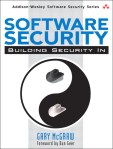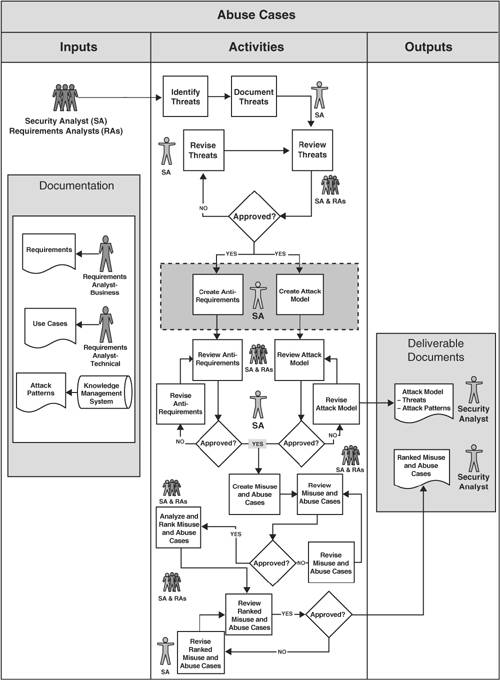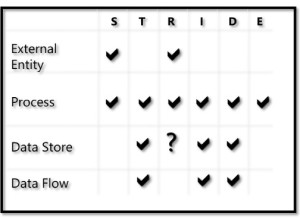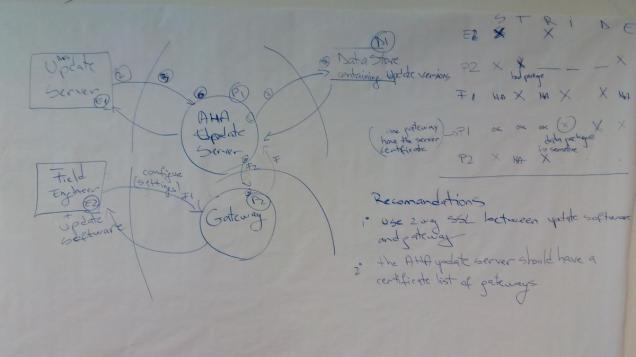Note: This notes were strongly inspired by the following books: CSSLP Certification All in one and Official (ISC)2 Guide to the CSSLP CBK, Second Edition
Design Process
Attack Surface Evaluation
 being exploited by a threat agent i.e., weaknesses in its entry and exit points that a malicious attacker can exploit to his or her advantage.
being exploited by a threat agent i.e., weaknesses in its entry and exit points that a malicious attacker can exploit to his or her advantage.Threat Modeling
The threat modeling process have 3 phases:
- model the system for which you want to find the threats.
- find the threats.
- STRIDE model.
- attack trees – An attack tree is a hierarchical tree-like structure, which has either an attacker’s objective (e.g., gain administrative level privilege, determine application makeup and configuration, bypass authentication mechanisms, etc.) or a type of attack
(e.g., buffer overflow, cross site scripting, etc.) at its root node.
- address each threat found in the previous step. Once identified,each threat must be evaluated according to the risk attached to it. There are several ways to quantitatively or qualitatively determine the risk ranking for a threat. These range from the simple, non-scientific, Delphi heuristic methodology to more statistically sound risk ranking using the probability of impact and the business impact.
- document and validate.
More details about threat modeling can be found here : Threat Modeling for mere mortals and (My) OWASP BeNeLux Days 2016 Notes – Training Day.
Design Considerations
This part is linked to the Secure Software Concepts and contains how the security software concepts can be applied to have a secured application.
- confidentiality – use cryptographic and masking techniques
- integrity – use hashing (or hash functions), referential integrity design (uses primary keys and related foreign keys in the database to assure data integrity), resource locking (when two concurrent operations are not allowed on the same object (say a record in the database), because one of the operations locks that record from allowing any changes to it, until it completes its operation, it is referred to as resource locking), and code signing.
- availability – replication, fail-over and scalability techniques can be used to design the software for availability.
- authentication – use multi-factor authentication and single sign on (SSO). Rely of already existing mechanism if possible (like the ones offered by the operating system).
- authorization – rely of already existing mechanism if possible.
- accounting (audit) – determine of what elements should be logged and under what circumstances.
- improper implementation of least privilege
- software fails insecurely
- authentication mechanisms are easily bypassed
- security through obscurity
- improper error handling
- weak input validation
Architecture system with secured design principles:
- good enough security – care should be taken to ensure that the security elements are in response with the actual risk associated with the potential vulnerability; do not over-engineer.
- least privilege – use of accounts with non-administrative abilities.
Modular programming is a software design technique in which the entire program is broken down into smaller sub-units or modules. Each module is discrete with unitary functionality and is said to be therefore cohesive, meaning each module is designed to perform one and only one logical operation.
- separation of duties – the programmer should not be allowed to review his own code nor should a programmer have access to deploy code to the production environment.
- defense in depth
-
use of input validation along with prepared statements or storedprocedures, disallowing dynamic query constructions using userinput to defend against injection attacks.
-
disallowing active scripting in conjunction with output encodingand input- or request-validation to defend against Cross-SiteScripting (XSS).
-
- fail safe
-
the user is denied access by default and the account is locked out after the maximum number (clipping level) of access attempts is tried.
-
errors and exceptions are explicitly handled and the error messages are non-verbose in nature.
-
not designing the software to ignore the error and resume nextoperation
-
- economy of mechanism – trade-off that happens between the
usability of the software and the security features that need to be designed and built in.
-
Unnecessary functionality or unneeded security mechanisms should be avoided.
- Strive for simplicity.
- Strive for operational ease of use.
-
- complete mediation –
- open design – the inverse of the open design principle is security through obscurity, which means that the software employs protection mechanisms whose strength is dependent on the obscurity of the design.
- least common mechanism – mechanisms common to more than one user or process are designed not to be shared. Design should compartmentalize or isolate the code (functions) by user roles, since this increases the security of the software by limiting the exposure.
- psychological acceptance – security principle that states that security mechanisms should be designed to maximize usage, adoption, and automatic application.The security protection mechanisms:
- are easy to use,
- do not affect accessibility.
- are transparent to the user.
- weakest link – when designing software, careful attention must be
given so that there are no exploitable components.
- leverage existing components – reusing tested and proven, existing libraries and common components has good security benefits.
Securing commonly used architectures
- mainframe architecture
- distributed architecture
- client/server
- p2p
- service oriented architecture
-
An ESB is a software architectural pattern that facilitates communication between mutually interacting software application.
- web-services
- SOAP
- REST
-
- rich internet aplications (RIA)
Service models:
-
Infrastructure as a Service (IaaS) -infrastructural components such as networking equipment, storage, servers and virtual machines are provided as services and managed by the cloud service provider.
-
Platform as a Service (PaaS) -in addition to infrastructural components, platform components such as operating systems, middleware and runtime are also provided as services and managed by the cloud service provider.
-
Software as a Service (SaaS) – in addition to infrastructural and platform components, data hosting and software applications are provided as services and managed by the cloud service provider.
Digital Rights Management
-
Open Digital Rights Language (ODRL) – A generalized, open standard under development that expresses rights using XML.
-
eXtensible rights Markup Language (XrML) – Another generalized REL that is more abstract than ODRL. XrML is more of a meta-language that can be used for developing other RELs.
-
Publishing Requirements for Industry Standard Metadata(PRISM) – Unlike ODRL and XrML, PRISM can be used to expressrights specific to a task and is used for syndication of print mediacontent such as newspapers and magazine.
Trusted computing:
- Trusted Platform Module (TPM) – specification used in personal computers and other systems to ensure protection against disclosure of sensitive or private information as well as the implementation of the specification itself.
- Trusted Computing Base (TCB) – the set of all hardware, firmware and software components that are critical to its security.













You must be logged in to post a comment.